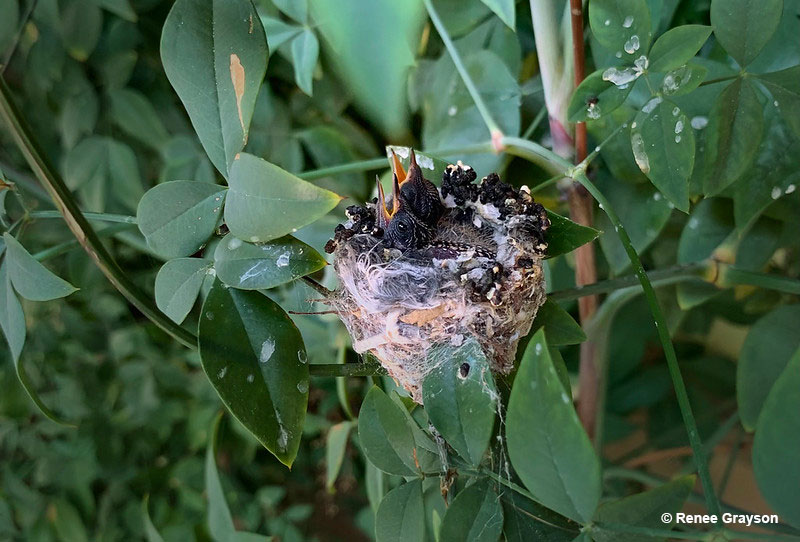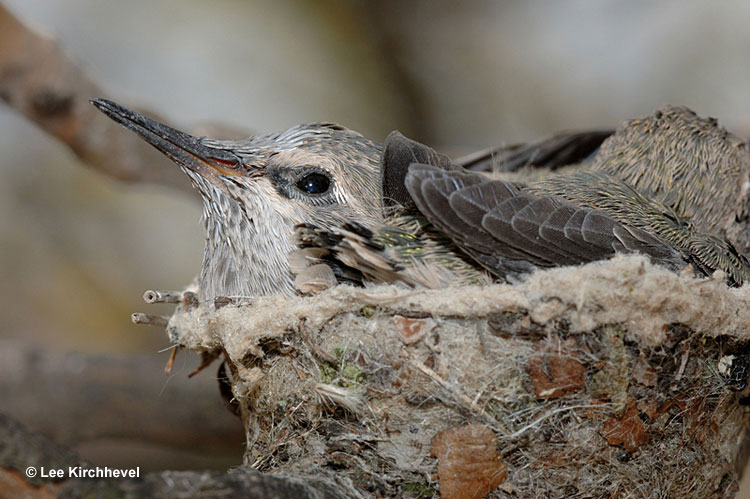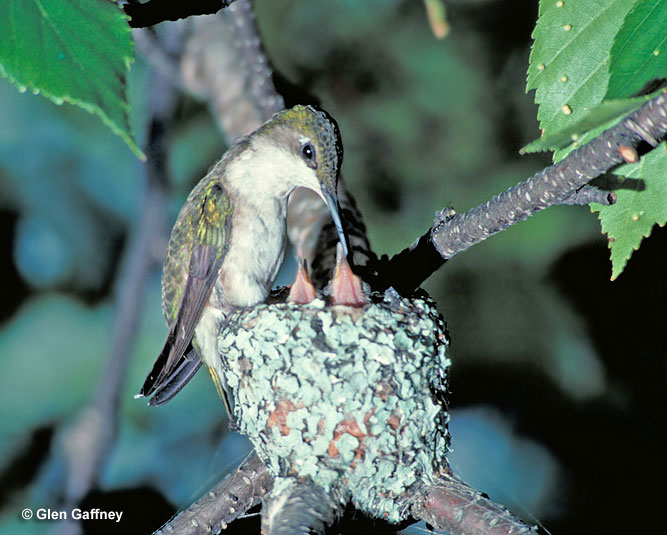
Baby hummingbirds are some of the animal kingdom’s tiniest and most fascinating creatures.
They are about the size of a Cheetos ball, and their eggs are even smaller, roughly the size of a jellybean. You probably won’t even see them until they leave their nests because their nests are also tiny and well-camouflaged.
Read on to discover everything you need to know about baby hummingbirds!
On this page
Nest
Hummingbirds are known for their remarkable flying abilities and vibrant colors, but their nests are equally fascinating.
They are highly selective in choosing the location for their nests, opting for safe and sheltered locations that protect their offspring from the elements and predators.
Hummingbird nests are usually located in thin forked branches of a tree, in dense bushes, or along thin plant branches.

The female hummingbird builds the nest on her own. Most common materials include moss, lichen, plant down, spider silk, fine plant fibers, feathers, fuzz, fur, hairs, and bits of bark or leaves.
The nest is a dense elastic cup that expands as the hatchlings grow. Most are about the size of a ping-pong ball. The height at which it is built varies depending on the species but is typically between 10 to 90 feet high.
Related: Do hummingbirds mate for life?
Hummingbirds typically have one to three broods a year, with each clutch containing one to three, most often two eggs.
Hummingbird eggs are about the size of a jellybean and are generally white. The female incubates the eggs for about two weeks and raises the chicks on her own. The offspring stay in the nest for about three weeks after hatching, during which they have to be constantly fed.
After the chicks leave the nest, they stay with their mother for around another seven days. During this time, she feeds them and teaches them how to find food on their own.
Once they are fully independent, the chicks will leave their mother and start their own lives.
What Does a Baby Hummingbird Look Like?
Newly hatched hummingbirds are some of the animal kingdom’s tiniest and most fragile creatures. They are only about an inch long and weigh only around 0.02 ounces, which is roughly the weight of a single paperclip. At birth, they are naked, with their eyes closed, and completely helpless.
The skin color of newly hatched hummingbirds varies between dark gray, slaty, and pink, with only a few yellow strands running down their backs.
After about 7 to 10 days, the baby hummingbirds begin to grow pin feathers, which are the precursor to their adult feathers. Over the next week or so, their feathers grow longer and become more pronounced.
By the time they are two weeks old, the baby hummingbirds are ready to fledge.
Related: Baby Birds – From Hatching to Adulthood
Juvenile hummingbirds most often resemble females of their species, with muted colors and fewer distinguishing features than adult males.
As they mature, their feathers will grow to be more vibrantly colored and patterned, and they will begin to develop the unique features that distinguish them as adults.
The most vibrant common specimen are Ruby-Throated Hummingbirds, Anna’s Hummingbirds, Rivoli’s Hummingbirds, and Calliope Hummingbirds.

How to Tell Baby Hummingbirds Apart?
Identifying the species of a baby hummingbird can be quite a challenge. There are a few key features that can help you distinguish them from other birds’ offspring and also between different hummingbird species.
First of all, you know you’re dealing with a baby hummingbird when the hatchling is very small and light, only about an inch long. They are also born naked, with their skin varying from dark gray to slaty to pink, and have only a few yellow strands running down their backs.
In terms of specific species characteristics, it is important to consult a field guide or other reliable reference to learn about the distinctive features of each species. You can determine which hummingbird baby you’ve encountered by comparing information about its range and habitat.
If they’re older, then you can also identify the species by its plumage and coloration. The easiest way to figure out the specific species would be to look for and identify the adult hummingbird that visits the nest and takes care of the nestlings.
What Do Baby Hummingbirds Eat?
As with all young animals, baby hummingbirds need a steady supply of nutritious food to grow and remain healthy. In the case of hummingbirds, protein is a particularly important component of their diet.
Related: What do baby birds eat?
To ensure that her chicks receive the protein they need, the mother hummingbird drinks nectar and eats a variety of soft-bodied bugs and insects, including insect eggs, fruit flies, mosquitoes, gnats, and others. She then returns to the nest and inserts her bill into her babies’ mouths, regurgitating the partially digested food for them to consume.
The frequency with which baby hummingbirds need to be fed is quite remarkable. To keep up with their rapid growth and metabolism, they must be fed every 20 minutes.
This means that the mother bird must be constantly on the lookout for sources of food and must be able to return to the nest quickly and efficiently.
Young hummingbirds fledge and leave the nest about three weeks after hatching. Their mother will take care of and feed them for about another week. After that, their flying and foraging skills should be developed enough to fend for themselves.
Frequently Asked Questions
How come you never see baby hummingbirds?
Seeing a baby hummingbird is very rare because their nests are tiny and incredibly well hidden.
What time of year do hummingbirds have their babies?
Most hummingbird species lay eggs in spring and summer, although the specifics depend on the species and location.
How long does it take for a baby hummingbird to fly?
Baby hummingbirds can fly roughly 3 weeks after hatching. They start to exercise their wings at about 2 weeks of age.
How big are baby hummingbirds when they leave the nest?
Baby hummingbirds are a fair bit heavier and larger than adults when they leave the nest which helps them sustain themselves until they’ve mastered necessary foraging skills.

Barbara
Tuesday 24th of October 2023
I just saw a tiny hummingbird (?) eating from my bougainvillea. Body was an inch long and the last half of his body looked like a bumblebee. Fuzzy with black and light stripes. From the wings forward, it was a hummer. Never saw this before
Patrick O'Donnell
Tuesday 24th of October 2023
@Barbara- Thanks for sharing your sighting! It sounds like you may have seen a sphynx moth. Amazingly, these small moths look a lot like hummingbirds and feed on the same flowers.